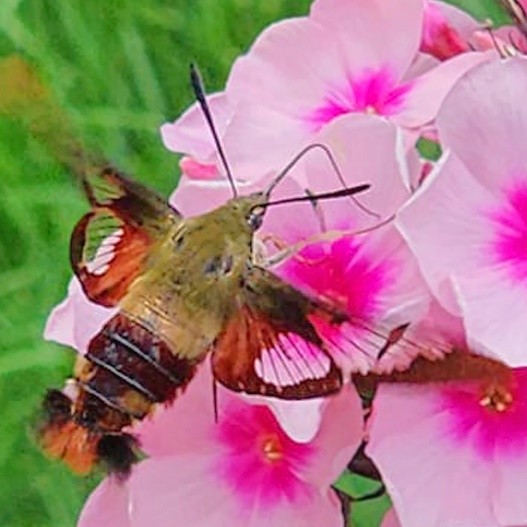
Rural Perspectives
It’s a bird … no, it’s a bug … oh, it’s a Hummingbird Moth
by Diane Constable

has see-through wings that span 1.5 inches
and can flap up to 70 beats per second.
Photo credit: Diane Constable
If you see what you think is a small hummingbird in your garden, you might want to look closer—it could be the hummingbird clearwing moth. Its scientific name is Hemaris thysbe.
This moth gets its name because of the resemblance to hummingbirds in both looks and actions. Unlike most moths, it is out and about in the daytime feeding on the nectar of various plants, particularly those plants that attract butterflies and hummingbirds. The hummingbird moth prefers pink-to-red flowers such as the phlox, pictured here, dianthus, and bee balm. It is a good pollinator, particularly for wildflowers and garden flowers.
This moth has see-through wings that span 1.5 inches and can flap up to 70 beats a second; its wings enable the moth to fly up to 12 miles per hour. It has a 1.5-inch-long, plump body, like a bumble bee, and its back wings are much shorter than its forward wings. The moth’s coloring makes it hard for its predators to find it.
They lay their tiny green eggs in the spring on viburnum, honeysuckle, hawthorn and cherry trees and will hatch in seven days. After about four weeks, the caterpillars drop to the ground and burrow in to form a chrysalis, emerging as an adult in the spring. They will live about seven months.
Fun Fact: Although about half the size of the adult hummingbird, this moth has a similar body shape. Much like the bird, it can fly in different directions, hover above a plant as it feeds, flap its wings nearly as quickly and in the same figure-eight pattern, and create a similar humming sound.
 Diane Constable is an avid photographer. She serves on the Unadilla Township Planning Commission and is a member of the township’s Parks and Recreation Committee. Diane also enjoys her dogs and gardening.
Diane Constable is an avid photographer. She serves on the Unadilla Township Planning Commission and is a member of the township’s Parks and Recreation Committee. Diane also enjoys her dogs and gardening.


